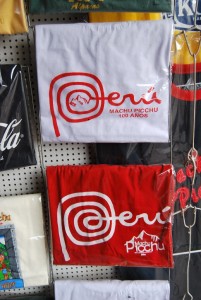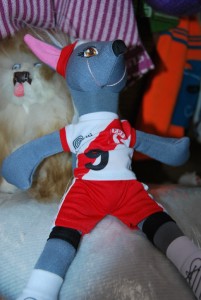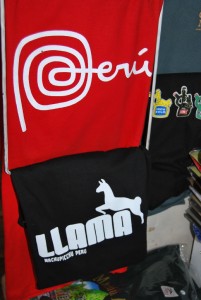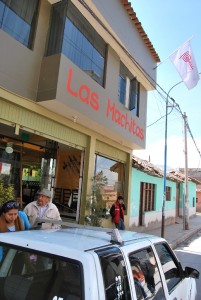Two Notes on a Red and White Line: The Marca Perú

Peru recently announced the symbol that serves as its mark for purposes of trade and tourism, as well as national identification. Cuzco Eats presents two notes, one from Cuzco and one from the United States, on this important event.
Peru is stylish these days, as one of the world’s major tourist destinations. The designation of Machu Picchu as one of the worlds seven wonders no doubt gives added force to this, as does the international attention given to Peruvian gastronomy and the country’s efforts to obtain for it the designation of “Patrimony of Humanity” from the United Nations. Peru shines these days in the faces of the world. And, to continue and enhance this glow, Peru developed the Marca Peru that is now generating even more demand.
Every traveler who arrives in Peru, from airport stores to handicraft markets, will find items carrying the Marca Peru. Most will be unable to resist their allure and will purchase something with this mark to take home with them. It is already rare to see travelers who are not wearing this mark.

Everywhere this symbol is for sale. Not only foreigners, but also Peruvians, are snapping it up. The creation of the Marca Peru has generated much demand. It is hoped that, when combined with traditional tourist images and crafts, the Marca Peru will lead to an increase in sales and the generation of more income, as well as more desire by outsiders to visit Peru.
Machu Picchu is glorious. But it is hoped that the association of the Marca Peru with it will now lead people to want to visit other areas of Peru also covered with that mark, so that tourism in Peru can grow, all the while admission to Machu Picchu must be limited.

This initiative was taken to strengthen the identity of the country internationally. The Marca Peru was principally developed by PromPeru–the Commission for the Promotion of Peru for Exports and Tourism (Comisión de Promoción del Perú para la Exportación y el Turismo) along with the invaluable support of the Cancillería (the Peruvian Department of State) and Proinversion–the Agency for the Promotion of Private Investment (Agencia de Promoción de la Inversión Privada). As a result, it was a fully coordinated government action to bring greater visibility to the country in what was called the “Marca Pais”, or the Country’s Mark.
The Marca Peru project appeared in mid 2009. It primarily sought to foment internationally three pillars: tourism, investment, and export. In this way, the Marca Peru sought to bring distinction and recognition to Peru to enhance its efforts to compete with other countries that were also seeking to attract foreign investment, tourism and improve demand for their exports.
Many specialists were involved in the design of the logo and the task was complicated by the multicultural complexity of the country. But in the end a spiral design in the colors of the national flag, red and white, was chosen. The spiral is meant to represent both the earth and the letter “P”. It also refers to one of the graphic motifs most commonly found in all of Peru’s cultures, at the same time it suggests a fingerprint. As a result, it is hoped people will see the concept that “there is a Peru for everyone”.

The Meanings and Transformations of a Mark.
By David Knowlton
It seems such a simple thing, the Marca Peru: a red line that begins as if it were going to make a square before dancing into a circle and finishing in a small flourish–the letters “erú”.. With them, the first dance, like the wind, or ancient pictographs, or maybe the Nazca lines, becomes Peru, a tall and simple act of creation.
Despite the complexity of the symbol, and the created nation it implies and invokes, the Marca Peru does seem simple, simple and elegant. But the word. Not Perú, “Marca”. It means mark, like a trace or the whorls of an inked finger on paper. As such we could simply say it is a symbol that stands for the country, like its flag.

But it also means “trademark” like Kleenex and Xerox, Big Mac, or Coca Cola, as if it needed a symbol to follow it, the “R” in a circle–®–that says the mark is more than the property of a business, it is legally registered with the government which will protect rights to its use, including meanings that people may give it since all of that increasingly matters to trade.
Yet trade does not seem the same thing as a country, despite numbers like “Gross Domestic Product” that seem to make it so, since trade is done by private industries and businesses while the country is public and belongs to all its citizens.
But the business meaning of “marca” is contradictorily strengthened and softened by another translation “brand”. Yeah, the brand is something business take care to create carefully and which arguably has a lot of value, since it stands for them in relation to their consumers. But the word has escaped the world of commerce and also stands for the image of celebrities, such that in the public’s eye their complex and contradictory humanity gets reduced to a few key things that are easily called up.
In either case, both the businesses and the celebrities loose lots of themselves by being reduced to a brand at the same time they gain a lot in the market place for standing out competitively. It is as if at a barbecue, instead of grilling the beef we grilled the brand seared on their hide by a red-hot iron. Or it is as if when eating the steak, instead of its proteins and flavors we tasted that scar as studies seem to indicate we do.
Sure, part of this marking, this branding, is as old as humans learning culture, learning to be different from other people, and recognizing that difference in themselves and others.

In traditional Peru it is still common for new-born babies to be wrapped in cloth. A wide “faja”—or woven belt—with symbols of life and identity, is wrapped first around their legs and then up their bodies, until they become a torpedo-torpedo-shaped bundle that can be worn on the mother’s back. The cloth and the symbols carry out a key idea that to be a human being is to wear cloth with symbols on it that connect her or him with other human beings.
While people in urban Cuzco debate whether it is still proper to bind babies in this traditional fashion, a new mark is given them.
This Marca Peru with its skillful joining of meanings–business and country, government and trade, ancient civilization and modern marketing—changes them at the same time it fills so many with enthusiasm and joy.
Much can be said, and will be said, about this new symbol and its social realities. But for now it is enough to note that while the mark claims the people of Peru and their culture, it is also in essence property and, as a result, potentially if not essentially private. We will see how this new joining of private interest and public good plays out. But no matter what, its sudden appearance announces a major change in Peru and its people’s relationship to it.




